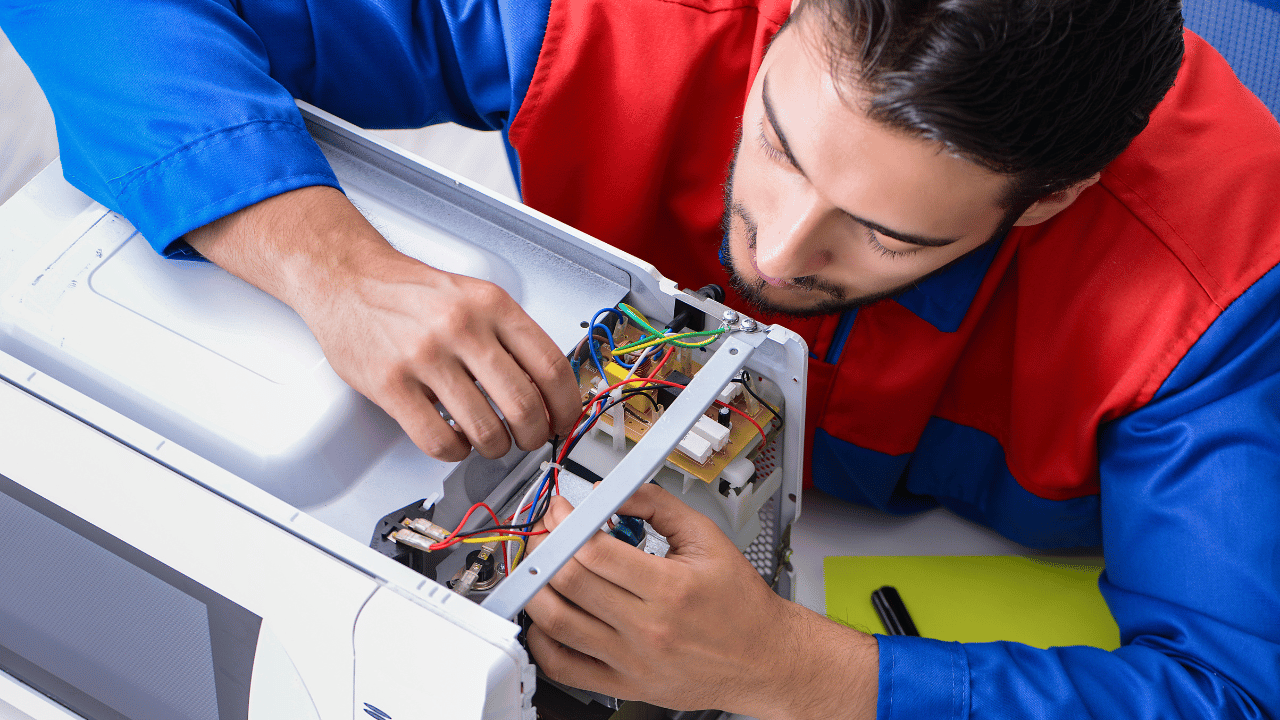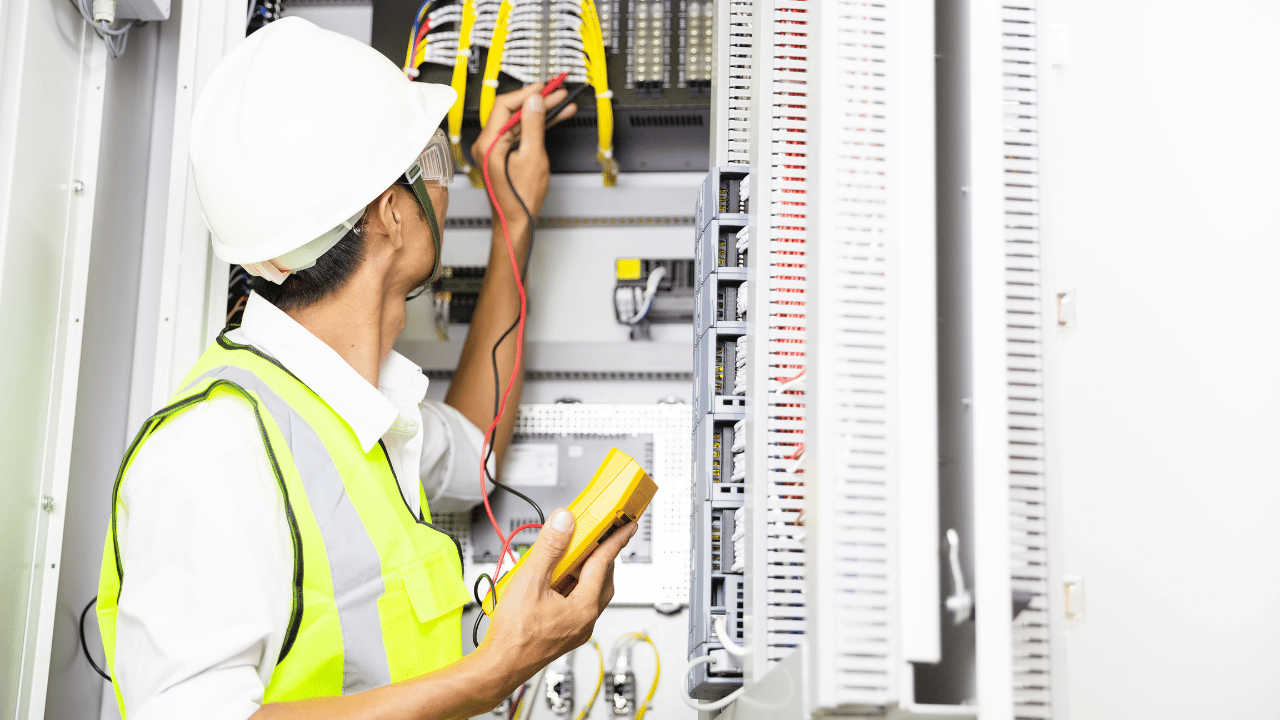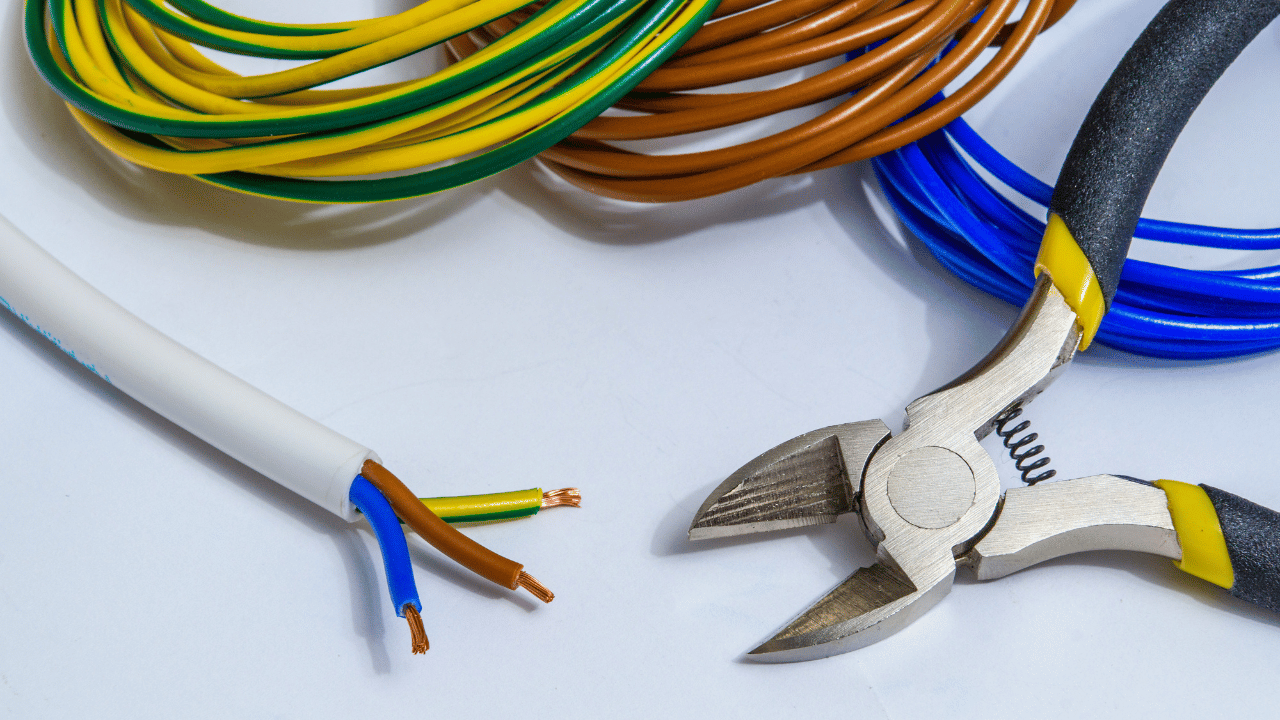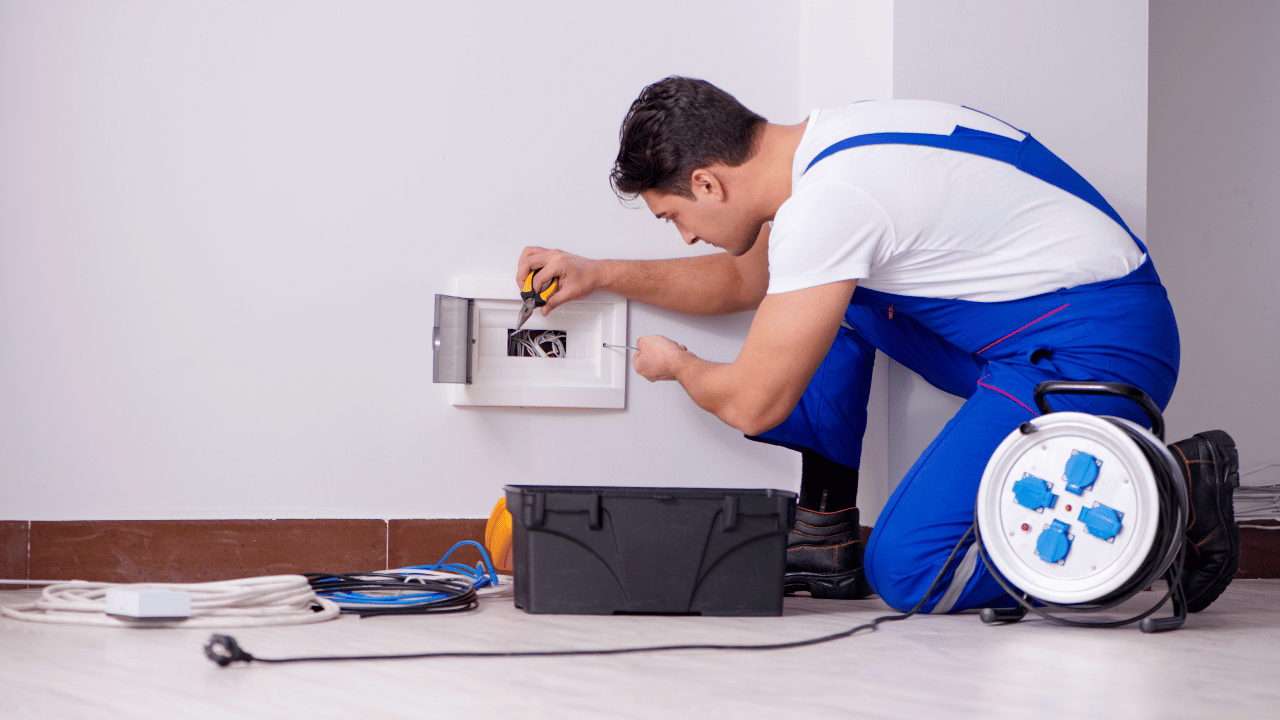Last Updated on October 21, 2023 by Pro Handyman Australia – Editorial Team
The modern home is a complex symphony of gadgets, appliances, and devices, each singing to the tune of electricity. Yet, as we’ve all experienced at some point, this symphony can sometimes be interrupted by an unexpected discord. A flickering light, an outlet that’s suddenly inert, or the confounding scenario where a particular device won’t work in one room but works perfectly in another. Welcome to the world of home electrical issues! This blog dives deep into the common (and some not-so-common) electrical challenges homeowners face. Whether you’re a DIY enthusiast hoping to understand your home’s wiring better or just someone looking to identify when it’s time to call a professional electrician, we’ve got you covered. Join us as we demystify the maze of home electrical problems and arm you with the knowledge to troubleshoot with confidence.
Identifying and Addressing Common Home Electrical Issues

Light Switch Concerns
A non-responsive light switch can be caused by various factors. Firstly, consider examining the bulbs in the associated light fixture. While LED bulbs are known for their longevity, they aren’t immune to occasional failures. Replacing a malfunctioned bulb is often the quickest solution.
However, if the switch mechanism feels loose, it could be a sign of a broken switch, warranting a replacement. A warm switch or one emitting a buzzing sound further confirms a defect within its components. Another consideration is the home’s service panel. A tripped circuit breaker or a blown fuse might be the culprit behind the non-functioning switch. Continuous tripping can hint at a wiring short circuit, in which case consulting a licensed electrician is recommended.
Addressing Light Switch Malfunctions
If you’ve ever encountered a non-responsive light switch, your first action might understandably be to examine the light bulbs in the fixture. With the progression in technology, LED light bulbs have a longer lifespan. However, they aren’t exempt from occasional malfunctions. Before diving into complex diagnostics, simply trying out a new bulb might be the solution you need.
In some instances, the root of the issue might be the switch mechanism itself. A tangible sign of this would be a switch that feels loose when operated. A broken toggle will necessitate a switch replacement. Similarly, if upon touch, the switch feels warm or emits a humming sound, this is an indicative sign of a faulty component, demanding immediate replacement.
Another frequent cause behind an inoperative light switch is a tripped circuit breaker or a blown fuse. It’s advisable to navigate to your service panel to identify the pertinent breaker or fuse. A tripped breaker should be reset, while a blown fuse requires replacement. Consistent tripping can be a sign of short-circuiting in the system, and in such scenarios, procuring the services of a licensed electrician is a wise decision.
The Challenge of Flickering Lights
Flickering lights, while a nuisance, can also be a symptom of a larger electrical issue. Begin by ensuring that all bulbs are firmly screwed into their fixtures. Over time, bulbs can loosen, and a poor connection results in flickering. Flickering lights, beyond being a mere annoyance, can serve as a harbinger of more severe electrical complications. They can sometimes elevate the risk of fire hazards.
Should you observe flickering lights, an initial approach should involve securing any slackened bulbs in your fixtures. Over time, bulbs might lose their grip, and an inadequate contact between the bulb and its base will manifest as flickering.
Post this preliminary check, your attention should divert to the light switch. Ageing switches, particularly the dimming variety, might not pair well with contemporary LED bulbs. Ensuring compatibility between bulb ratings and switches is a crucial step. The switch might also house loose wiring leading to flickers. It’s essential to remember that aged outlets and slackened wiring can be conduits for electrical shocks. When faced with sparks or mild shocks from switches or cords, prioritize their replacement, ensuring the power is turned off from the main panel before commencing any repair work.
Decoding High Electrical Bills

Surprisingly high energy bills can be attributed to appliances that remain plugged in even when idle. Contemporary appliances, despite their energy-efficient design, can still draw electricity consistently when plugged. An effective countermeasure involves connecting such appliances to power strips and ensuring they are turned off, especially during inactive periods.
While evaluating appliance usage, it’s beneficial to reconsider utilization patterns. Appliances like dishwashers, washing machines, and dryers are significant energy consumers. Optimal efficiency can be achieved by loading these devices to their full capacity, ensuring reduced operation cycles and lower energy expenses.
Furthermore, the age of appliances plays a pivotal role in energy consumption. For instance, refrigerators, despite having a lifespan extending over a decade, can exhibit deteriorated seals or door gaskets earlier. Consequently, the appliance overworks to maintain optimum temperatures. This principle of age-induced inefficiency is applicable to various appliances, including dishwashers and furnaces. As appliances age, they inherently demand more energy, regardless of the upkeep standards maintained.
Understanding Power Surges and Brownouts
Power surges and brownouts, although distinct, often stem from analogous causes. Natural incidents like lightning strikes or external obstructions, such as a tree branch colliding with a power line, can precipitate both. To counteract potential damage to your home appliances from such events, incorporating surge protectors or an uninterruptible power system (UPS) can be a prudent decision.
However, it’s imperative to recognize that these electrical fluctuations can also be initiated by internal issues. Electrical overloads, a consequence of connecting numerous devices to a singular circuit, frequently result in both power surges and brownouts. Similarly, compromised or deteriorating wiring can instigate an electrical malfunction, leading to both of these disturbances. To mitigate this, ensure that your devices are judiciously distributed to prevent circuit overloading. Notably, substantial appliances such as refrigerators and air conditioning units should operate independently without sharing a circuit. And, for persistent or recurrent electrical inconsistencies, enlisting the expertise of a licensed electrician to assess your home’s wiring integrity and adherence to codes is advisable.
The Importance of Prompt Action
Though some electrical issues may seem minor, they can be indicative of more profound, potentially hazardous problems. Recognizing and addressing any electrical anomalies promptly can not only safeguard your home but also ensure the well-being of its occupants.
Identifying Electrical Issues in Your Residence
The convenience of electricity is indispensable, illuminating our living spaces, moderating our home’s temperature, and fueling myriad appliances vital to our daily routines. Yet, the same energy source that promises comfort can also pose hazards. As cited by the Electricity Safety Foundation International, annually, electrical complications are responsible for over 50,000 house fires, a majority of which are preventable.

Often, the perils associated with electrical glitches are concealed within your home’s infrastructure. Recognizing early warning signs can not only safeguard your residence but also lead to timely, cost-effective resolutions. Here are some indicators to help you discern potential electrical concerns and the subsequent steps to consider:
Detecting Unusual Odors
When a new appliance is initially activated, you might notice a distinct scent, often attributable to its paint or finish. However, if an unusual smell originates from an electrical outlet, it’s crucial to disconnect any devices linked to it and abstain from using it until a certified electrician has inspected it. Similarly, if your fuse box or breaker panel emits any peculiar odors, it’s imperative to engage an electrician without delay.
Addressing Arc Faults
Arc faults manifest when electrical currents deviate from their designated route, frequently due to compromised wiring. Such anomalies often culminate in electrical fires. Nevertheless, this risk can be mitigated through the implementation of an arc-fault circuit interrupter (AFCI). It’s advisable to employ a professional electrician to install these devices. Their initial cost is offset by the peace of mind they provide, especially in vintage homes where wiring might be aged or deteriorated.
Avoiding Counterfeit Electrical Merchandise
Approach with caution if you encounter electrical products, such as extension cords or night lights, being offered at significantly discounted prices, like at flea markets. There’s a plausible risk that these items might be counterfeit, falling short of industry or regulatory benchmarks, thereby heightening the potential for hazards. It’s wise to procure electrical goods from renowned dealers, ensuring the product carries the validation seal from the Underwriters Laboratory (UL).
Monitoring Outlets and Switches
A telltale sign of electrical concerns is when your light switches radiate heat or if there are sparks emanating from outlets. If either of these situations arises, it’s essential to solicit the expertise of a licensed electrician to evaluate whether your wiring necessitates refurbishments or if fixtures need replacement.
Heeding Audible Alerts
Typically, your switches and outlets should function silently. Any audible buzzing, crackling, or sizzling sounds when engaging a switch or connecting to an outlet are cause for concern. If confronted with such anomalies, immediately deactivate the power to that particular fixture and reach out to a professional electrician for guidance.
Understanding Flickering Lights
Flickering lights can be a symptom of power surges. Contrary to popular belief, these surges aren’t always the result of major incidents. Often, they’re due to your appliances demanding more power than your electrical system can provide. Continuous power surges can adversely affect your appliances and electrical fixtures. Should you notice persistent flickering lights, it might indicate a need for an electrical system overhaul or wiring upgrade.
Navigating Issues with Switches and Outlets
Non-functional or intermittently working switches and outlets can hint at underlying loose wiring, posing potential fire risks. Furthermore, loose outlets can present a risk of electrical shocks. An outlet that is even slightly exposed might cause an unexpected shock to someone attempting to connect or disconnect a cord.
Monitoring Ceiling Fixtures
It’s advisable to periodically inspect the vicinity of your ceiling fixtures for unusual warmth. Such heat might suggest inadequate insulation or bulbs with wattages higher than recommended, both of which can lead to potential fire hazards. For a safer alternative, consider transitioning to compact fluorescent light (CFL) or light-emitting diode (LED) bulbs. These options tend to generate less heat compared to traditional incandescent bulbs.
Remain Vigilant to Rodent Activity
Rodents such as mice and rats have an affinity for gnawing on electrical wires. Frayed or compromised wiring presents a clear and imminent fire risk. If you spot rodent droppings or evidence of their activity in areas like the attic, basement, or near electrical fixtures, inspect all nearby wiring for potential damage. If a rodent infestation is suspected, enlisting the expertise of a pest control specialist can aid in both identifying and rectifying the issue.
Addressing Circuit Breaker Complications
Circuit breakers play a crucial role in ensuring electrical safety. They’re engineered to trip when they detect circuit overloading, thereby preventing overheating and potential fire hazards. While the occasional tripping might simply denote a minor overload, frequent tripping warrants attention. Under such circumstances, it’s paramount to engage a professional electrician to conduct a thorough assessment of your electrical system.
Safety First: Pre-Troubleshooting Protocols

Before embarking on any troubleshooting or repair, always ensure your safety.
a. Turn Off the Main Power: Always switch off the main power source to prevent any electrical shock.
b. Use Insulated Tools: If you’re making any adjustments, use rubber-handled or insulated tools.
c. Wear Protective Gear: Use rubber gloves and protective eyewear.
d. Don’t Work in Damp Areas: Water is a good conductor of electricity. Avoid troubleshooting in wet or damp areas.
e. When in Doubt, Seek Expertise: If you’re ever unsure, it’s always safer to consult with or hire a professional.
DIY Electrical Fixes vs. Hiring a Professional

While some minor issues, such as changing a light bulb or resetting a tripped circuit, can be handled at home, there are instances when professional help is a must.
DIY-Friendly Tasks:
- Replacing light bulbs.
- Resetting tripped circuits.
- Changing batteries in smoke detectors.
- Tightening loose outlets.
Professional-Requiring Tasks:
- Replacing or repairing wiring.
- Addressing repeated circuit breaker trips.
- Installing new electrical panels.
- Fixing buzzing or warm outlets.
- Any task where you feel uncertain or unsafe.
The Imperative of Hiring Professionals for Electrical Concerns
While the DIY movement has empowered homeowners to tackle a variety of tasks, when it comes to electrical problems, the importance of seeking the expertise of a professional cannot be overstressed. The intricate and high-risk nature of electrical work demands the experience and knowledge that only a licensed electrician can offer. Here’s why it’s essential to call in the experts for electrical issues:

1. Safety First
Electrical tasks aren’t just complicated—they can be downright dangerous. A slight oversight can lead to shocks, serious injuries, or even fatalities. Professionals are trained to approach electrical problems with utmost caution, ensuring the safety of everyone involved.
2. Preventing Bigger Issues
What might seem like a minor electrical problem can be symptomatic of a much larger issue. A licensed electrician can diagnose the root cause, ensuring that small problems don’t escalate into significant, costlier issues down the line.
3. Knowledge of Building Codes
Electrical work must adhere to specific building codes and standards. A professional will ensure that all installations and repairs comply with these regulations, preventing potential legal complications.
4. Assurance of Quality Work
Electricians undergo rigorous training and regular updating of their knowledge. This ensures they’re equipped to handle the complexities of the job. By hiring a professional, you’re assured of quality work, minimizing the need for recurrent repairs.
5. Cost-Efficient in the Long Run
Although hiring a professional might seem expensive upfront, in the long run, it’s a cost-saving move. Properly addressed electrical issues reduce the risk of damages to appliances or the property, eliminating potential replacement or repair expenses.
6. Access to the Right Tools
Professional electricians are equipped with the latest tools and technologies tailored for specific tasks. This not only ensures efficiency but also minimizes the risks associated with using inappropriate tools.
7. Warranty and Peace of Mind
Many professional electricians offer warranties on their work. This provides homeowners with peace of mind, knowing that if an issue arises related to the repair or installation, the electrician will address it without additional charges.
8. Comprehensive Solutions
While you might call an electrician for a specific problem, they can also assess other potential issues in your home. Their holistic view can identify and address concerns you might not have even been aware of.
9. Time Efficiency
With their expertise, professional electricians can diagnose and remedy issues more quickly than someone without the necessary training. This efficiency ensures minimal disruptions to your daily routine.
10. Insurance Considerations
Many home insurance policies mandate that electrical work be carried out by licensed professionals. DIY electrical fixes might void your insurance coverage in the event of related damages.
While the allure of DIY projects is undeniable, electrical problems require a unique blend of expertise and caution. Hiring a professional electrician is not just a smart choice—it’s the safest and most efficient way to ensure the integrity of your home’s electrical system.
Conclusion

Electrical systems, while offering immense convenience, can pose challenges and hazards if not maintained or addressed properly. This guide serves as a primer for homeowners looking to troubleshoot minor electrical issues. However, always remember the golden rule: Safety first. If a problem seems too complicated or potentially dangerous, it’s always best to call in a professional electrician. Your home’s safety, and more importantly, your safety and that of your loved ones, should always be the top priority.
